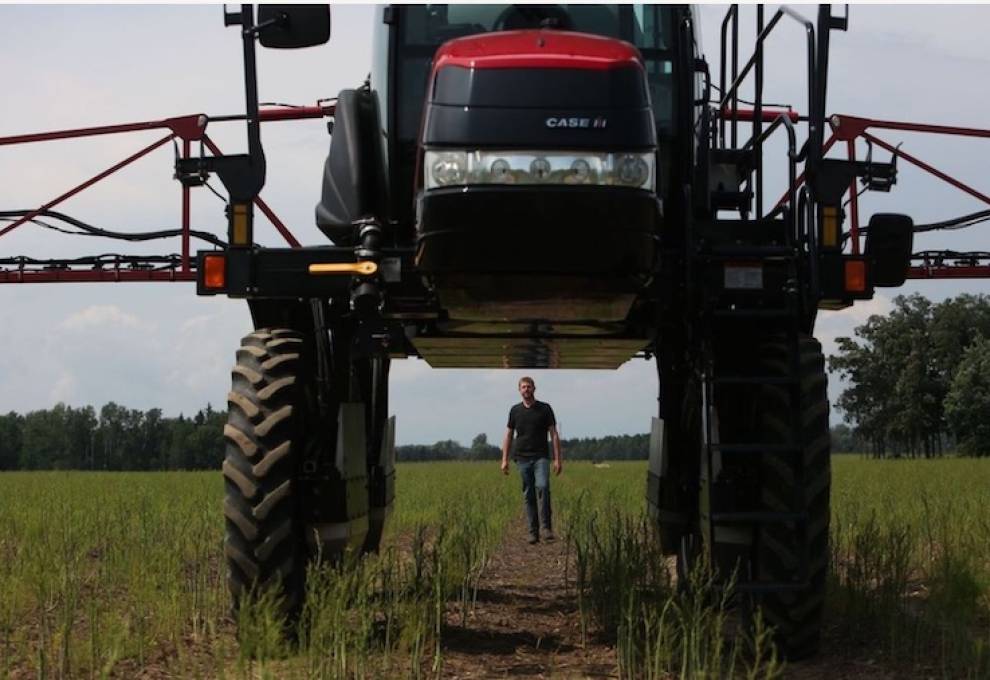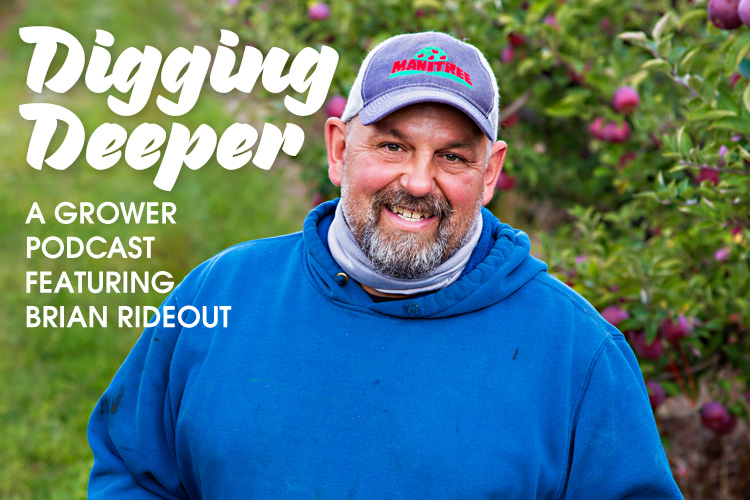
Big acres, big boom. That’s the equipment needed to cover the needs of Mike Chromczak who farms asparagus, watermelon and row crops near Brownsville, Ontario.
While a sprayer might be hard at work in the field, it’s not necessarily spreading fungicide for Stemphylium leaf blight. It might be foliar fertilizer to boost plant health and stimulate flower growth.
That’s the big paradigm shift that’s under way says Brian Rideout, chair of the crop protection section, Ontario Fruit and Vegetable Growers’ Association (OFVGA). Rather than a crop protection program, he thinks in terms of a plant health program.
“The learning curve is not gentle,” says Rideout, who manages Manitree Fruit Farms, 400 acres of apples, tender fruit, strawberries and vegetables near Blenheim, Ontario. “It’s a whole-farm approach, not a spot approach. It used to be that you’d pick a target acreage and use that as a model for the farm. That no longer works.”
Rideout’s transition to integrating biologicals with chemicals has been 20 years in the making. With the registration of more single-site, crop protection products with specific modes of action, Rideout has turned to more biological products that have broad-spectrum control or at least suppression properties.
“This is how you build resistance management on the farm,” Rideout explains. “I’m now using fewer conventional products. The building block of plant health is with nutrient management – phosphorus and potassium – to strengthen the immune response of plants.”
He realizes that growers aren’t confident yet about a system that requires deeper understanding of the biology of their crops and soil. That in turn requires more awareness of life cycles of disease and insects. He admits that crop scouting is required every two or three days rather than once a week. And the timing of spraying must be well considered, in sync with what’s actually happening in the orchard or field. In the case of the farm’s strawberry production, the number of chemical sprays has been reduced from six to three by increasing soil and foliar nutrition.
These mindset changes are no surprise to Jouke Sypkes, horticultural product manager for Belchim Crop Protection since 2015.
“The transition we are in favours a more balanced approach to crop health: where biology and chemistry both play significant roles,” he says from his base in Guelph, Ontario. “In crop health programs, we talk about the grower option of bio-priority where biologicals are prioritized in the short term. If there is interest in developing a biology-first approach, we’ll recommend inserting specific bio-stimulants to achieve a specific goal. Bio-pesticides are added to target specific pests on a preventive schedule and/or conventional chemistries are used as targeted, precision applications when thresholds are reached.”
Sypkes has observed a trend of biologicals adoption over the years. Early in his career, he witnessed first-hand how quickly a small genetic pool of insects developed resistance to chemicals in closed environments. That’s why greenhouse growers adopted biological controls so early in their evolution. These growers now have 30+ years of experience. The next sector to adopt are growers of high value horticulture crops such as grapes, apples and berries. Some tree fruit and grape growers, for example, are using root dips and soil drenches when planting new trees to ensure strong root formation and a healthy root microbiome. The company’s root inoculant, BioCult, is showing good results.
New environmental issues – climate change, invasive pests and viruses -- are pressuring growers to consider a more nuanced approach. Biological products offer another set of tools to help set crops up for success in increasingly difficult conditions.
For growers, it can be a difficult transition. The payoff isn’t always immediate. But Sypkes points out that there are many bio-stimulants readily available to boost plant health and resilience in the current season. For example, a silicon product, Kazoo, is a foliar spray that strengthens plant infrastructure improving nutrient use efficiency and increasing the physical barrier to disease and insects. A calcium product, Inca, improves calcium mobility in fruit, improving plant health and crop quality parameters. Biopesticides, such as Double Nickel can simply be alternated with existing chemistry in current programs to reduce overall reliance on good conventional tools and reduce the risk of their resistance.
“This paradigm shift is more complex but also more engaging for growers because it’s a systems approach to growing,” says Sypkes. “The farm is an eco-system.”
Increased on-farm adoption of biological crop protection solutions also reflects the trend towards a growing share of new registrations in recent years says Chris Duyvelshoff, crop protection advisor for the Ontario Fruit and Vegetable Growers’ Association. Since 2020, the Pest Management Regulatory Agency (PMRA) has registered a total of 34 new active ingredients in Canada. More than half of these new registrations – a total of 19 – are considered to be biological products.
“While growers are still learning to adopt more biological solutions into their conventional crop protection programs, there are also a lot more available than five or 10 years ago,” says Duyvelshoff.
A smaller share of new conventional active ingredients registered also reflects the ever increasing cost of bringing a new conventional active ingredient to market. A 2023 survey on behalf of CropLife International estimated this at more than $300 million U.S. dollars - increasing from $184 million in 2000. While spending on biological research and development was higher than ever, it still represented only a small fraction (7%) of the total R&D spending of the five biggest crop protection companies participating in the survey. It may also reflect the fact some biologicals may not require the same number of studies compared to conventional active ingredients. Regardless of how you slice it, companies are spending a lot on crop protection R&D – conventional or biological.
“Science has become a major part of the farm,” says Rideout. “Fortunately, farmers are citizen scientists who are ultra-observant. They can tell you exactly what the conditions were in any given year over a lifetime of farming.”
That’s what Rideout is living today in his evolving awareness of what’s happening on the farm. The spray program he used in 2023 is likely not the template for 2024.
“Your Sunday afternoon is gone because that’s when you’re experimenting with a small block,” Rideout concludes.

The Grower is Digging Deeper behind the story above and speaking with Brian Rideout, tender fruit and apple farmer and Crop Protection Section Chair, OFVGA. He shares his personal experiences with integrating biologicals on his farm. This podcast is sponsored by Cohort Wholesale. Listen here >>

Add new comment